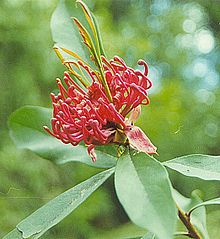Grevilleoideae
This article needs additional citations for verification. (December 2018) |
| Grevilleoideae | |
|---|---|

| |
pin-cushion hakea (Hakea laurina )
| |
| Scientific classification | |
| Kingdom: | Plantae |
| Clade: | Tracheophytes |
| Clade: | Angiosperms |
| Clade: | Eudicots |
| Order: | Proteales |
| Family: | Proteaceae |
| Subfamily: | Grevilleoideae Engl. |
| Genera | |
|
See text | |
The Grevilleoideae are a subfamily of the plant family Proteaceae. Mainly restricted to the Southern Hemisphere, it contains around 46 genera and about 950 species. Genera include Banksia, Grevillea, and Macadamia.
Description
The Grevilleoideae grow as trees, shrubs, or subshrubs. They are highly variable, making a simple, diagnostic identification key for the subfamily essentially impossible to provide. One common and fairly diagnostic characteristic is the occurrence of flowers in pairs that share a common bract. However, a few Grevilleoideae taxa do not have this property, having solitary flowers or inflorescences of unpaired flowers. In most taxa, the flowers occur in densely packed heads or spikes, and the fruit is a follicle.
Distribution and habitat
Grevilleoideae are mainly a Southern Hemisphere family. The main centre of diversity is
Taxonomy





The framework for classification of the Proteaceae was laid by
- Tribe incertae sedis
Roupaleae
Authority:
- incertae sedis
- Megahertzia — Knightia — Eucarpha — Triunia
- Subtribe B.G.Briggs
- Subtribe B.G.Briggs
- Subtribe B.G.Briggs
- Subtribe B.G.Briggs
- incertae sedis
Banksieae
Authority: Rchb.
- fossil form genera
- Subtribe B.G.Briggs
- Subtribe B.G.Briggs
Embothrieae
Authority: Rchb.
- Subtribe B.G.Briggs
- Subtribe Endl.
- Telopea
- Subtribe B.G.Briggs
- Subtribe Endl.
- Opisthiolepis — Buckinghamia — Hakea — Grevillea — Finschia
- Subtribe
Macadamieae
Authority: Venk.Rao
- Subtribe B.G.Briggs
- Subtribe Malagasiinae P.H.Weston & N.P.Barker
- Subtribe Virotiinae P.H.Weston & N.P.Barker
- Subtribe B.G.Briggs
- Cardwellia — Euplassa — Gevuina — Bleasdalea — Hicksbeachia — Kermadecia
- Subtribe
Uses

The
References
- ^ Orchard, Anthony E.; McCarthy, Patrick (eds.). "Proteaceae". Flora of Australia, Volume 16: Elaeagnaceae, Proteaceae 1. Melbourne: Australian Biological Resources Study / CSIRO Publishing. Retrieved 2006-06-28.
- .
- doi:10.7751/telopea20065733. Archived from the original(PDF) on 2009-10-02.
